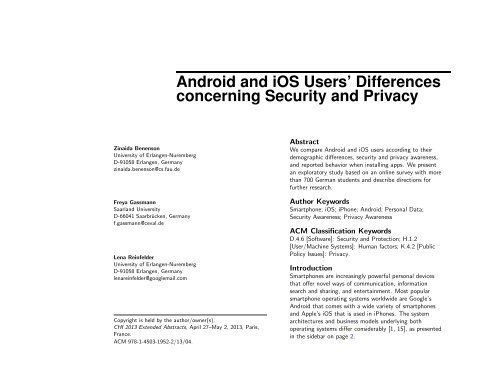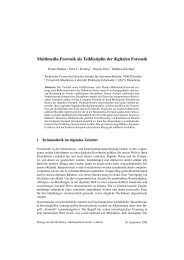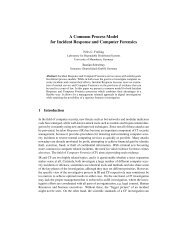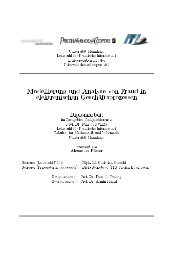Android and iOS Users' Differences concerning Security and Privacy
Android and iOS Users' Differences concerning Security and Privacy
Android and iOS Users' Differences concerning Security and Privacy
You also want an ePaper? Increase the reach of your titles
YUMPU automatically turns print PDFs into web optimized ePapers that Google loves.
<strong>Android</strong> <strong>and</strong> <strong>iOS</strong> Users’ <strong>Differences</strong><br />
<strong>concerning</strong> <strong>Security</strong> <strong>and</strong> <strong>Privacy</strong><br />
Zinaida Benenson<br />
University of Erlangen-Nuremberg<br />
D-91058 Erlangen, Germany<br />
zinaida.benenson@cs.fau.de<br />
Freya Gassmann<br />
Saarl<strong>and</strong> University<br />
D-66041 Saarbrücken, Germany<br />
f.gassmann@ceval.de<br />
Lena Reinfelder<br />
University of Erlangen-Nuremberg<br />
D-91058 Erlangen, Germany<br />
lenareinfelder@googlemail.com<br />
Copyright is held by the author/owner(s).<br />
CHI 2013 Extended Abstracts, April 27–May 2, 2013, Paris,<br />
France.<br />
ACM 978-1-4503-1952-2/13/04.<br />
Abstract<br />
We compare <strong>Android</strong> <strong>and</strong> <strong>iOS</strong> users according to their<br />
demographic differences, security <strong>and</strong> privacy awareness,<br />
<strong>and</strong> reported behavior when installing apps. We present<br />
an exploratory study based on an online survey with more<br />
than 700 German students <strong>and</strong> describe directions for<br />
further research.<br />
Author Keywords<br />
Smartphone; <strong>iOS</strong>; iPhone; <strong>Android</strong>; Personal Data;<br />
<strong>Security</strong> Awareness; <strong>Privacy</strong> Awareness<br />
ACM Classification Keywords<br />
D.4.6 [Software]: <strong>Security</strong> <strong>and</strong> Protection; H.1.2<br />
[User/Machine Systems]: Human factors; K.4.2 [Public<br />
Policy Issues]: <strong>Privacy</strong>.<br />
Introduction<br />
Smartphones are increasingly powerful personal devices<br />
that offer novel ways of communication, information<br />
search <strong>and</strong> sharing, <strong>and</strong> entertainment. Most popular<br />
smartphone operating systems worldwide are Google’s<br />
<strong>Android</strong> that comes with a wide variety of smartphones<br />
<strong>and</strong> Apple’s <strong>iOS</strong> that is used in iPhones. The system<br />
architectures <strong>and</strong> business models underlying both<br />
operating systems differ considerably [1, 15], as presented<br />
in the sidebar on page 2.
<strong>Android</strong> Business Model<br />
Google provides free services<br />
<strong>and</strong> sells ads there, <strong>Android</strong><br />
being one of the services.<br />
Apps h<strong>and</strong>ling: Anyone can<br />
develop <strong>and</strong> distribute <strong>Android</strong><br />
apps. Although there is<br />
the official Google Play store,<br />
the apps can also be distributed<br />
from any other place.<br />
<strong>iOS</strong> Business Model<br />
Apple has the integrated<br />
model, where <strong>iOS</strong> (software)<br />
is integrated with the iPhone<br />
(hardware).<br />
Apps h<strong>and</strong>ling: <strong>iOS</strong> apps<br />
can only be developed by subscribers<br />
to the <strong>iOS</strong> Developer<br />
Program, <strong>and</strong> can only be distributed<br />
through the official<br />
App Store.<br />
As an exception, organizations<br />
that participate in the<br />
<strong>iOS</strong> Developer Enterprise Program<br />
can develop <strong>and</strong> distribute<br />
in-house apps solely to<br />
their employees.<br />
Ad Networks Integration<br />
App developers for either platform<br />
can earn money by integrating<br />
ad networks into their<br />
apps. This business model for<br />
app developers should not be<br />
confused with Google’s business<br />
model.<br />
It is widely believed that also the user communities of<br />
<strong>Android</strong> <strong>and</strong> <strong>iOS</strong> differ from each other. Although we<br />
could not find reliable scientific data, we could compile a<br />
list of differences from personal communication <strong>and</strong><br />
different press sources [5, 1]. Probably most poignantly<br />
these differences are pictured in the cartoon by Idan<br />
Schneider (Fig. 1). The <strong>Android</strong> users are assumed to be<br />
mostly male <strong>and</strong> technically savvy, the iPhone users are<br />
said to be very loyal to Apple <strong>and</strong> be more br<strong>and</strong>-aware in<br />
general.<br />
An app is usually written by a third party. It has to be<br />
downloaded <strong>and</strong> installed from an app store, <strong>and</strong> the users<br />
has limited possibilities for knowing which information the<br />
app might collect about them, or what hidden<br />
functionality the app might have. Thus, app usage is often<br />
connected to security <strong>and</strong> privacy risks. The differences<br />
between <strong>Android</strong> <strong>and</strong> <strong>iOS</strong> apps <strong>concerning</strong> security <strong>and</strong><br />
privacy are presented in sidebars on pages 3 <strong>and</strong> 4.<br />
In this work we assume that these differences are<br />
connected to the differences in perception <strong>and</strong> behavior of<br />
the users with respect to security <strong>and</strong> privacy. We note<br />
that it is not clear in which direction the influence might<br />
work, <strong>and</strong> we do not attempt to answer causal questions<br />
here. Thus, our main research question is formulated as<br />
follows:<br />
Are there differences in attitudes <strong>and</strong> behavior between<br />
<strong>Android</strong> <strong>and</strong> <strong>iOS</strong> users <strong>concerning</strong> security <strong>and</strong> privacy<br />
when using apps?<br />
Related Work<br />
We are only aware of two studies that explicitly mention<br />
the differences between <strong>Android</strong> <strong>and</strong> <strong>iOS</strong> users with<br />
respect to security <strong>and</strong> privacy.<br />
Figure 1: “iPhone vs. BlackBerry vs. <strong>Android</strong>”, Cartoon<br />
courtesy of Idan Schneider, C-Section Comics,<br />
www.csectioncomics.com.<br />
Chin et al. [3] primarily investigated differences in<br />
perceptions <strong>and</strong> behavior of users when they are using a<br />
laptop vs. a smartphone. However, as they chose to test<br />
30 <strong>Android</strong> users as well as 30 <strong>iOS</strong> users, they noticed<br />
that <strong>Android</strong> users had more free apps than <strong>iOS</strong> users.
<strong>Android</strong> <strong>and</strong> <strong>iOS</strong> <strong>Security</strong><br />
<strong>Android</strong> malware is quite numerous<br />
[7], as anyone can develop<br />
<strong>and</strong> distribute <strong>Android</strong><br />
apps. Although scanning of<br />
the apps from Google Play for<br />
malicious functionality started<br />
in 2012, this was found to be<br />
not quite effectual [13]. Besides,<br />
nothing prevents users<br />
from downloading malicious<br />
apps from elsewhere [16].<br />
<strong>iOS</strong> malware is rare [7], because<br />
all apps in the App Store<br />
undergo a review process in order<br />
to ensure that the apps<br />
work according to their description.<br />
This also means that<br />
the apps should not have malicious<br />
functionality. Nevertheless,<br />
some malware <strong>and</strong> spyware<br />
found its way into the<br />
store [14, 2].<br />
Jailbreaking <strong>iOS</strong> or Rooting<br />
<strong>Android</strong> gives the users privileged<br />
(root) access to their devices.<br />
This way the users get<br />
much more control (e.g., the<br />
<strong>iOS</strong> users can install apps from<br />
other sources than App Store).<br />
However, the devices loose protection<br />
given by their operating<br />
systems <strong>and</strong> become an easy<br />
target for malware.<br />
Furthermore, around 20 % of <strong>Android</strong> users stated that<br />
they always consider permissions when installing apps, <strong>and</strong><br />
additional 40 % stated that they sometimes considered<br />
permissions. This is an interesting contrast to the results<br />
by Felt et al. [8] that only 17 % of <strong>Android</strong> users pay<br />
attention to the permissions during the installation<br />
process.<br />
King [11] explicitly compares 13 <strong>Android</strong> <strong>and</strong> 11 <strong>iOS</strong> users<br />
according to their privacy concerns <strong>and</strong> expectations. She<br />
hypothesized that the Apple review process causes <strong>iOS</strong><br />
users to exhibit more trust into the apps. However, she<br />
found out that also <strong>Android</strong> users thought that Google<br />
reviews apps (this fact is also confirmed by Kelley et<br />
al. [10]), <strong>and</strong> so no difference between platforms could be<br />
observed. Users that believed (falsely or not) that the<br />
apps are reviewed felt safer when using apps.<br />
As Apple <strong>and</strong> Google chose quite different ways of<br />
informing users of apps’ data usage (see sidebar on<br />
page 4), some differences in privacy concerns <strong>and</strong> privacy<br />
awareness emerged during the study. <strong>iOS</strong> users were<br />
mostly unaware of data usage by the apps (<strong>iOS</strong> 6 was not<br />
released at that time). In contrast, <strong>Android</strong> users were<br />
aware of the permission screen that is always shown during<br />
the installation, although the majority of them felt that<br />
they do not quite underst<strong>and</strong> what the permissions mean.<br />
This feeling is confirmed by other user studies [10, 8, 12].<br />
Furthermore, <strong>iOS</strong> users were less privacy concerned <strong>and</strong><br />
less privacy aware than <strong>Android</strong> users. They thought that<br />
apps needed access to more data, <strong>and</strong> were more<br />
comfortable with data sharing. Moreover, <strong>iOS</strong> users were<br />
much more comfortable with real-time location sharing<br />
than <strong>Android</strong> users. This difference is probably influenced<br />
by the runtime consent that <strong>iOS</strong> users need to give for<br />
location-aware apps.<br />
<strong>Android</strong> users received the most attention to date in<br />
connection with the <strong>Android</strong> permissions [10, 8, 12].<br />
Although different research strategies <strong>and</strong> different user<br />
pools were considered, the researchers uniformly found<br />
that most users pay only limited attention to the<br />
permissions <strong>and</strong> have a poor underst<strong>and</strong>ing of their<br />
meaning. We are not aware of any studies that specifically<br />
concentrated on security- or privacy-related human factors<br />
for <strong>iOS</strong> users.<br />
Study Design <strong>and</strong> Data Collection<br />
As not much data is available about the comparison of<br />
<strong>Android</strong> <strong>and</strong> <strong>iOS</strong> users, we conducted an exploratory<br />
study using a short online questionnaire.<br />
Hypotheses<br />
We were primarily interested in the differences between<br />
<strong>Android</strong> <strong>and</strong> <strong>iOS</strong> users <strong>concerning</strong> security <strong>and</strong> privacy<br />
issues. We also wanted to check if there is a grain of<br />
truth in the demographic differences as depicted in Fig. 1.<br />
Therefore, we formulated the following five hypotheses.<br />
H1: Female users are more likely to have an iPhone.<br />
H2: If users have a technical background, then they are<br />
more likely to have an <strong>Android</strong> phone.<br />
H3: If users are br<strong>and</strong>-aware, then they are more likely to<br />
have an iPhone.<br />
H4: Having an <strong>Android</strong> phone is positively correlated to<br />
being more security aware.<br />
H5: Having an <strong>Android</strong> phone is positively correlated to<br />
being more privacy aware.<br />
The last two hypotheses are based on the reflection that<br />
Google’s open app market makes <strong>Android</strong> users more
H<strong>and</strong>ling of Personal Data<br />
in <strong>Android</strong> <strong>and</strong> <strong>iOS</strong><br />
<strong>Android</strong> permissions are<br />
warnings that are automatically<br />
generated from the app<br />
code if the app accesses or<br />
manipulates certain data, such<br />
as contacts, messages, system<br />
settings. The warnings are<br />
presented to the users during<br />
the installation process, <strong>and</strong><br />
they have to agree with all<br />
permission requests in order to<br />
install the app. Thus, the users<br />
only have the “all-or-nothing”<br />
choice.<br />
<strong>iOS</strong> prior to <strong>iOS</strong> 6 required<br />
from the users runtime consent<br />
if an app wanted to use location<br />
data for the first time.<br />
Many other types of user data<br />
could be read <strong>and</strong> manipulated<br />
without user’s explicit consent<br />
[14, 4].<br />
<strong>iOS</strong> 6 (released on 19 Sept.<br />
2012) radically changed the<br />
h<strong>and</strong>ling of the personal data.<br />
Now users have to give runtime<br />
consent for many more data<br />
types, such as contacts, calendar,<br />
photos, Twitter or Facebook<br />
account. Users can also<br />
customize their data disclosure<br />
policies using a wide set of privacy<br />
settings.<br />
conscious of possible malware infections, <strong>and</strong> that the<br />
explicitly presented app permissions draw user attention<br />
to the possibilities of data misuse. On the other h<strong>and</strong>, it<br />
is also possible that security <strong>and</strong> privacy aware users<br />
choose <strong>Android</strong> because it is open source, <strong>and</strong> because<br />
they can see in the permissions which data is accessed<br />
<strong>and</strong> manipulated by the apps.<br />
Operationalization of Variables<br />
Technical background (H2) was operationalized in two<br />
ways: (1) study of a technical subject or work in a<br />
technical field, <strong>and</strong> (2) interest in technology. The latter<br />
was measured using five new items in the style of the<br />
questionnaire developed by Karrer et al. [9].<br />
We define br<strong>and</strong>-awareness (H3) as the extent to which<br />
the product’s br<strong>and</strong> influences the decision to use the<br />
product. We asked the participants to rate the importance<br />
of smartphone manufacturer (such as Apple, Samsung,<br />
Nokia etc.) for the choice of their gadget.<br />
For hypotheses H4 <strong>and</strong> H5, we decided to look for<br />
indicators that people think about security <strong>and</strong> privacy<br />
when using their smartphone. We first asked participants<br />
an open-ended question about factors that influence them<br />
when choosing an app. After that we asked if the<br />
participants have a virus scanner installed. Participants<br />
that mentioned security- or privacy-related factors for<br />
their app choice without priming were considered security<br />
vs. privacy aware. Participants that have a virus scanner<br />
were considered security aware.<br />
Data Collection<br />
We conducted an online survey with the students of the<br />
economics department <strong>and</strong> of the technical department at<br />
the University of Erlangen-Nuremberg in September 2012.<br />
The link to the questionnaire was distributed via email. In<br />
order to avoid priming, we called the survey “How well do<br />
you know your smartphone?”.<br />
<strong>iOS</strong> 6 was released on 19th September 2012, in the<br />
middle of our study. As new features <strong>and</strong> release date of<br />
new <strong>iOS</strong> versions are usually treated in a manner of a<br />
“state secret”, we were not fully aware of the <strong>iOS</strong> 6<br />
changes, <strong>and</strong> so we did not ask the users to provide the<br />
version of their operating system. Thus, we cannot use<br />
the data of <strong>iOS</strong> users provided after September 19th for<br />
analysis of anything <strong>concerning</strong> privacy. Moreover,<br />
according to statistical data [6], around 60 % of German<br />
<strong>iOS</strong> users updated their devices to <strong>iOS</strong> 6 by the beginning<br />
of October.<br />
Thus, we ended up with two data sets. We use the full<br />
data set for analysis of hypotheses H1 to H4 that are not<br />
connected to privacy, <strong>and</strong> we use a restricted set of data<br />
collected before September 19th for analysis of H5.<br />
Results<br />
Demographics of Participants<br />
We received 917 completed questionnaires. After sorting<br />
out inconsistent data <strong>and</strong> users that had other kinds of<br />
smartphones, 722 valid answers remained. From these,<br />
506 (70 %) were <strong>Android</strong> <strong>and</strong> 216 (30 %,) were <strong>iOS</strong><br />
users. More than 80 % of the participants were between<br />
18 <strong>and</strong> 25 years old, <strong>and</strong> 14 % were between 26 <strong>and</strong> 30.<br />
36 % were female <strong>and</strong> 64 % male.<br />
Evaluation of Hypotheses<br />
Hypotheses H1 to H4 were evaluated on the full data set<br />
using logistic regression with IBM SPSS Statistics 20. We<br />
used the operating system as the dependent variable<br />
(Table 1).
β<br />
Gender 0.445 + 1.902<br />
(0.234)<br />
Tech. 0.088 0.411<br />
subject (0.214)<br />
Interest in −0.351 ∗∗ -2.721<br />
technology (0.129)<br />
Technical 0.535 ∗∗∗ 4.652<br />
features (0.115)<br />
Hardware −0.717 ∗∗∗ -7.793<br />
producer (0.092)<br />
Friend’s −0.231 ∗∗ -2.852<br />
opinion (0.081)<br />
Virus 1.265 ∗∗∗ 6.521<br />
scanner (0.194)<br />
Constant: 0.433, n: 722<br />
Nagelkerkes R 2 : 0.293<br />
+ p < 0.10, ∗ p < 0.05,<br />
∗∗ p < 0.01, ∗∗∗ p < 0.001<br />
β ∗ = st<strong>and</strong>ardized β<br />
β ∗<br />
Table 1: Logistic regression with<br />
operating system as dependent<br />
variable. Variables representing<br />
age <strong>and</strong> occupation are omitted.<br />
They were not significant. Tech.<br />
subject indicates technical study<br />
subject or field of work (7 % of<br />
respondents were not students).<br />
Interest in Technology was<br />
derived from five technology<br />
interest questions (see page 4)<br />
using factor analysis (principal<br />
component analysis with Varimax<br />
rotation). All other variables are<br />
explained in the text.<br />
H1: Female users are more likely to have an iPhone.<br />
This hypothesis is weakly supported (p < 0.1). However,<br />
this may be due to the large sample size.<br />
H2: If users have a technical background, then they are<br />
more likely to have an <strong>Android</strong> phone.<br />
Studying a technical subject or working in a technical field<br />
were not correlated to having an <strong>Android</strong> phone.<br />
However, if technical features are an important factor for<br />
the choice of the smartphone, the person is significantly<br />
more likely to have an <strong>Android</strong> phone (variable Technical<br />
features, p < 0.001).<br />
On the other h<strong>and</strong>, the variable Interest in Technology<br />
has a negative effect. Persons interested in technology (as<br />
measured by our questionnaire items) are much more<br />
likely to have an iPhone (p < 0.01). To summarize, H2<br />
needs further investigation, especially the scale for<br />
measuring interest in technology should be reconsidered.<br />
H3: If users are br<strong>and</strong>-aware, then they are more likely to<br />
have an iPhone.<br />
This hypothesis is supported. Persons that stated that the<br />
phone manufacturer’s br<strong>and</strong> influenced them when<br />
choosing a smartphone, are significantly more likely to<br />
have an iPhone (p < 0.001). Also persons that said that<br />
the opinion of friends, family <strong>and</strong> colleagues affected them<br />
when choosing their smartphone, are more likely to have<br />
an iPhone (variable Friend’s opinion, p < 0.01).<br />
H4: Having an <strong>Android</strong> phone is positively correlated to<br />
being more security aware.<br />
Persons who stated to have a virus scanner installed on<br />
their smartphone are significantly more likely to have an<br />
<strong>Android</strong> phone (p < 0.001). 38 % of all <strong>Android</strong> users<br />
said that they have a virus scanner installed.<br />
We note, however, that it is not clear whether having a<br />
virus scanner can be considered as an independent<br />
variable, because there are many virus scanners for<br />
<strong>Android</strong>, <strong>and</strong> virtually no virus scanners for <strong>iOS</strong>. One may<br />
also argue that more security aware people would probably<br />
choose <strong>iOS</strong> because of the Apple review process. This<br />
question needs further investigation.<br />
H5: Having an <strong>Android</strong> phone is positively correlated to<br />
being more privacy aware.<br />
Hypothesis 5 had to be evaluated on the data received<br />
before the release of <strong>iOS</strong> 6. As an indicator of privacy<br />
awareness we took answers to the open-ended question<br />
“Which factors are important to you when you consider to<br />
install an app?” Persons that mentioned personal data or<br />
permissions were considered privacy aware. Out of 322<br />
participants that answered the survey before September<br />
19th, 20% of <strong>Android</strong> users <strong>and</strong> 5% of the <strong>iOS</strong> users were<br />
privacy aware (Fig. 2). This difference is highly significant<br />
(Cramer’s V=0.207, p < 0.001). Thus, H5 is supported.<br />
Here, one may be tempted to argue, similarly to H4, that<br />
more privacy aware users might choose <strong>iOS</strong> because they<br />
trust that privacy invasive apps will not pass Apple’s<br />
review process. However, Apple’s review criteria are kept<br />
secret, <strong>and</strong> <strong>iOS</strong> apps are known to be quite privacy<br />
invasive from the literature [14, 4].<br />
Limitations<br />
Due to different policies of the two considered university<br />
departments for sending mass emails, we started the<br />
survey on September 11th in the economics <strong>and</strong> on<br />
September 23th in the technical department. Between the<br />
two email waves, <strong>iOS</strong> 6 was released. As we did not ask<br />
the participants about their <strong>iOS</strong> version, we could not<br />
separate <strong>iOS</strong> 6 users from the others. Therefore, for all
Figure 2: Participants that<br />
mentioned or not mentioned (in<br />
an open-ended question) privacy<br />
issues as a factor that they<br />
consider when installing apps.<br />
reliable results that concern privacy awareness we could<br />
only use the data of the economics department students.<br />
Unfortunately, in this way we could not see if there is a<br />
correlation between technical background <strong>and</strong> privacy<br />
awareness.<br />
Our results <strong>concerning</strong> the indicators of technological<br />
interest are ambiguous. That is, we are not sure what we<br />
actually measured with our five technology-related<br />
questions, <strong>and</strong> we are going to analyze this in more depth.<br />
Conclusions <strong>and</strong> Future Work<br />
Additional data from the presented study will be analyzed<br />
in order to generate hypotheses for the next stage of our<br />
examination. For example, the participants provided<br />
answers to an open-ended question “If the app wants to<br />
access the following data, then I do not use it.” We are<br />
going to categorize the data <strong>and</strong> look there for differences<br />
between the operating systems. Subsequently, we are<br />
going to conduct a set of experiments <strong>and</strong><br />
quasi-experiments using specially developed <strong>Android</strong> <strong>and</strong><br />
<strong>iOS</strong> apps, complemented by in-depth interviews.<br />
References<br />
[1] Arthur, C., <strong>and</strong> Dredge, S. <strong>iOS</strong> v <strong>Android</strong>: why<br />
Schmidt was wrong <strong>and</strong> developers still start on<br />
Apple. www.guardian.co.uk Jun. 10, 2012.<br />
[2] Bonnington, C. First Instance of <strong>iOS</strong> App Store<br />
Malware Detected. www.wired.com May 7, 2012.<br />
[3] Chin, E., Felt, A. P., Sekar, V., <strong>and</strong> Wagner, D.<br />
Measuring user confidence in smartphone security<br />
<strong>and</strong> privacy. In SOUPS (2012).<br />
[4] Egele, M., Kruegel, C., Kirda, E., <strong>and</strong> Vigna, G.<br />
P<strong>iOS</strong>: Detecting <strong>Privacy</strong> Leaks in <strong>iOS</strong> Apllications.<br />
In NDSS (2011).<br />
[5] Elmer-DeWitt, P. 6 ways iPhone <strong>and</strong> <strong>Android</strong> users<br />
differ. tech.fortune.cnn.com Feb. 25, 2010.<br />
[6] Etherington, D. Europeans Quickest To Adopt <strong>iOS</strong><br />
6. techcrunch.com Oct. 13, 2012.<br />
[7] Felt, A. P., Finifter, M., Chin, E., Hanna, S., <strong>and</strong><br />
Wagner, D. A survey of mobile malware in the wild.<br />
In SPSM (2011).<br />
[8] Felt, A. P., Ha, E., Egelman, S., Haney, A., Chin, E.,<br />
<strong>and</strong> Wagner, D. <strong>Android</strong> permissions: User attention,<br />
comprehension, <strong>and</strong> behavior. In SOUPS (2012).<br />
[9] Karrer, K., Glaser, C., Clemens, C., <strong>and</strong> Bruder, C.<br />
Technikaffinität erfassen – der Fragebogen TA-EG. In<br />
8. Berliner Werkstatt Mensch-Maschine-Systeme.<br />
(2009).<br />
[10] Kelley, P. G., Consolvo, S., Cranor, L. F., Jung, J.,<br />
Sadeh, N., <strong>and</strong> Wetherall, D. A conundrum of<br />
permissions: Installing applications on an <strong>and</strong>roid<br />
smartphone. In USEC Workshop (2012).<br />
[11] King, J. How Come I’m Allowing Strangers to Go<br />
Through My Phone?: Smart Phones <strong>and</strong> <strong>Privacy</strong><br />
Expectations. under review, 2012.<br />
[12] Lin, J., Sadeh, N., Amini, S., Lindqvist, J., Hong,<br />
J. I., <strong>and</strong> Zhang, J. Expectation <strong>and</strong> purpose:<br />
underst<strong>and</strong>ing users’ mental models of mobile app<br />
privacy through crowdsourcing. In ACM UbiComp<br />
(2012).<br />
[13] Percoco, N. J., <strong>and</strong> Schulte, S. Adventures in<br />
bouncerl<strong>and</strong>. In Black Hat USA (2012).<br />
[14] Seriot, N. iPhone <strong>Privacy</strong>. In Black Hat USA (2010).<br />
[15] Travlos, D. Five Reasons Why Google <strong>Android</strong> versus<br />
Apple <strong>iOS</strong> Market Share Numbers Don’t Matter.<br />
www.forbes.com Aug. 22, 2012.<br />
[16] Zhou, Y., Wang, Z., Zhou, W., <strong>and</strong> Jiang, X. Hey,<br />
You, Get Off of My Market: Detecting Malicious<br />
Apps in Official <strong>and</strong> Alternative <strong>Android</strong> Markets. In<br />
NDSS (2012).







